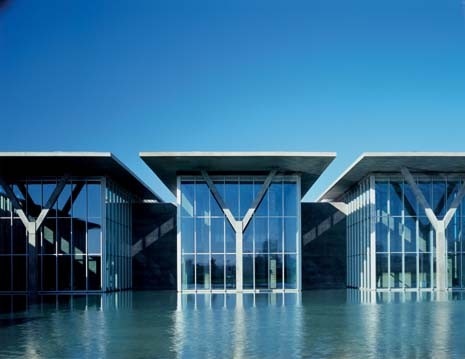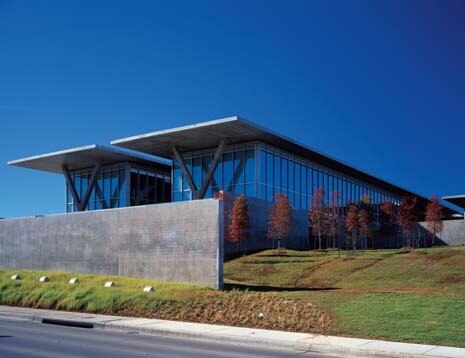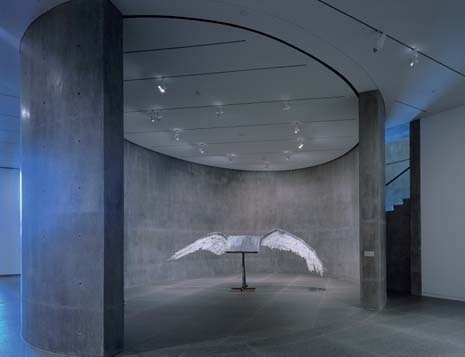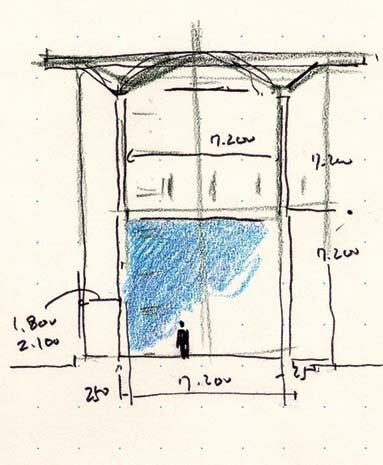The philanthropist Anne Marion purchased an expansive site for Fort Worth’s new Museum of Modern Art across the street from the Kimbell Art Museum. She also helped select Tadao Ando as its architect.
When someone apologized to Ando for the location’s lack of spectacular scenery, he replied, ‘The Kimbell is a mountain’. Ando has responded to Louis Kahn’s masterpiece by adopting a similar strategy, splitting his building into a reticent complex of linked pavilions. However, in contrast to the impassive, chapel-like forms of the earlier museum – a travertine-clad casket for precious jewels of classic and early modern art – Ando has infused the Modern, as it’s known in Fort Worth, with a sense of openness and elasticity.
In his largest overseas building to date, the architect has absorbed the spirit of place, providing an agora for the people of this sprawling prairie city as well as a dynamic showcase for contemporary art. The blank walls that conceal the core of his Japanese buildings, delaying revelation, have become transparent screens, blurring the divide between architecture and the fluidity of water and sky.
The sleek south front and the five jutting roof canopies to the west suggest a corporate campus, curtain-walled in glass and standing-seam aluminium. To the east, behind the gathering spaces and offices, three linked galleries project into a shallow reflecting pool surrounded by a concrete boundary wall. Cantilevered roof planes supported by Y columns shade the glass that is wrapped around the two-storey concrete galleries. The museum’s attention-grabbing signature is Richard Serra’s Vortex, a 21-metre-high cocoon of torqued Corten steel plates at the corner across from the Miro bronze that marks the entry to the Kimbell.
There is no need for signage within, for the body language of the building guides you through to the galleries beyond the lofty foyer and up the grand staircase to the second floor. To the left of the entrance is the shop and education department; to the right are the oak-panelled, 250-seat auditorium and the restaurant, which occupies an elliptical, glass-walled pavilion looking across the pool to the galleries. A narrow walkway borne by two slender, rounded columns links the second-floor offices at either end of the foyer.
Even before you engage with the art, Ando raises expectations with this serene, luminous space, which offers tantalizing glimpses of what lies beyond. The museum is a triumph of subtlety and restraint, employing the same few materials throughout, layering the spaces to produce a rich tapestry of perspectives and reflections.
The granite floors and walls of impeccably poured concrete gleam softly in the abundant natural light. At night, from the courtyard, the building resembles a row of lanterns floating in the water. Like the Kimbell, it offers an oasis for the spirit, a place of stillness and contemplation. It recalls Ando’s Chapel of the Light and his Water Temple on Awaji as much as his other museums.
The galleries comprise 5,400 of the 15,300 square metres (reduced from 7,500 in the original programme), making the museum’s size second to MoMA New York among American museums of modern art and giving it almost six times as much space as it had in its old building. Far more important than expanse is the hierarchy of the spaces and the way they flow together.
Double-height galleries with granite floors to support massive sculptures link intimate, white-walled, oak-floored rooms on the first and second levels. There is a rhythmic alternation of 13-metre bays with indirect clerestory lighting and eight-metre bays with skylights and fabric-lined translucent ceilings.
The harsh sun is diffused, deflected and filtered, but not denied. Wide openings with sharp-edged or chamfered concrete borders frame adjoining galleries, and balconies overlook the double-height spaces. Glazed ambulatories wrap the three gallery wings, dissolving in the ripples of the reflecting pool at the lower level and opening onto an upper-level sculpture terrace at the rear. Too many contemporary art museums are built for show. Monuments in search of a purpose, they treat art as incidental to public spectacle.
In Fort Worth, the public and curatorial roles are clearly distinct and mutually reinforcing. Director Marla Price led a team effort that made all the right moves, giving the competing architects a precise programme, winning public acclaim for Ando’s design and guiding the project to completion on schedule and within the $65 million budget. A fourth gallery wing was deferred, and the Y columns were moved outside the glass skin to free up space inside and provide better support for the cantilevered roof planes.
Aluminium cladding was substituted for glass on surfaces exposed to direct sun. Peter Arendt, who was hired as director of design and construction, praises Ando for his willingness to heed the client’s suggestions and modify his design without compromising its integrity. He engaged the architects in an ongoing dialogue, refining every detail of the building – right down to the handsome split benches of oak and steel used throughout the museum.
For the general contractor, the concrete posed a special challenge. In the United States, poured concrete is rarely exposed; the quality of formwork and detailing that distinguishes Ando’s work is seldom required and still more rarely achieved. Linbrook Construction was determined to please the architect and his exacting client. Extensive research in Japan, tests of different sands and repeated mock-ups brought success.
The surfaces are velvety and unflawed yet richly toned, avoiding the blandness that can occur when the mix is too pale and uniform. Patterns emerge, evoking weathered stone and extending one’s awareness of art into the circulation areas. In a city where temperatures reach 40 degrees Celsius in the summer, it was necessary to pour at night and even to add ice to the mix.
In the inaugural exhibition, chief curator Michael Auping has made brilliant use of the spaces to dramatize the strengths of this major collection of late-20th-century art. Anselm Kiefer’s Book with Wings expands to fill a concrete ellipse that serves as an intimate display area and as a kind of buffer to direct visitors up the main staircase. At the top of the stairs, a Warhol self-portrait – as lurid as any Japanese demon – anchors a blank wall.
At every turn, you find a work of art that has been so felicitously placed that you feel you are discovering the artist for the first time. At the far end, a narrow stair slices gently down through the space between concrete and glass walls as though it were carrying you into the shimmering pool. The Modern is the product of passion and meticulous planning, of a client who demanded excellence and an architect who responded enthusiastically to the challenge. In an era of empty show, it’s a building of substance, inspiring the casual visitor as much as the art aficionado.












